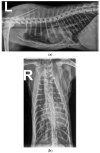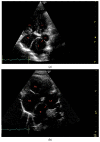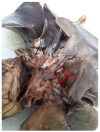A Case of Congenital Pulmonary Vein Stenosis with Secondary Post-Capillary Pulmonary Hypertension and Left Sided Congestive Heart Failure in a Cat
- PMID: 36669024
- PMCID: PMC9864943
- DOI: 10.3390/vetsci10010023
A Case of Congenital Pulmonary Vein Stenosis with Secondary Post-Capillary Pulmonary Hypertension and Left Sided Congestive Heart Failure in a Cat
Abstract
A five-month-old, 3.8 kg intact male Maine coon cat presented for dyspnea characterized by increased respiratory effort in addition to open-mouth breathing. Thoracic radiographs showed pectus excavatum, enlarged cardiac silhouette, and generalized interstitial patterns. Echocardiography revealed normal left atrial (LA) and left ventricular dimensions. A large tubular structure, suspected to be a distended pulmonary vein (PV), was identified as draining into the LA. Severe eccentric and concentric right ventricular hypertrophy and paradoxical septal motion were noted. Based on Doppler echocardiography, both pulmonary venous and pulmonary artery pressure was severely elevated. Clinical, radiographic, and echocardiographic abnormalities were hypothesized to result from pulmonary vein stenosis (PVS), causing severely elevated pulmonary venous pressures and resulting in clinical signs of left-sided congestive heart failure (L-CHF) and severe post-capillary pulmonary hypertension (Pc-PH). The prognosis for good quality of life was assessed as poor, and the owner elected euthanasia. Necropsy confirmed the presence of PVS with severe dilation of the PVs draining all but the left cranial lung lobe. All lung lobes except the left cranial lobe had increased tissue density and a mottled cut surface. This case report shows that, in rare cases, both L-CHF and Pc-PH may be present without LA enlargement. To the authors' knowledge, this is the first report on PVS in veterinary medicine.
Keywords: congenital heart disease; feline; pulmonary veins; stenosis.
Conflict of interest statement
The authors declare no conflict of interest.
Figures








References
-
- Allen H.D., Driscoll D.J., Shaddy R.E., Feltes T.F. Moss & Adams’ Heart Disease in Infants, Children, and Adolescents: Including the Fetus and Young Adult. Lippincott Williams & Wilkins; Philadelphia, PA, USA: 2013.
-
- Saad E.B., Rossillo A., Saad C.P., Martin D.O., Bhargava M., Erciyes D., Bash D., Williams-Andrews M., Beheiry S., Marrouche N.F. Pulmonary vein stenosis after radiofrequency ablation of atrial fibrillation: Functional characterization, evolution, and influence of the ablation strategy. Circulation. 2003;108:3102–3107. doi: 10.1161/01.CIR.0000104569.96907.7F. - DOI - PubMed
Publication types
LinkOut - more resources
Full Text Sources
Research Materials
Miscellaneous

